The Equity Imperative
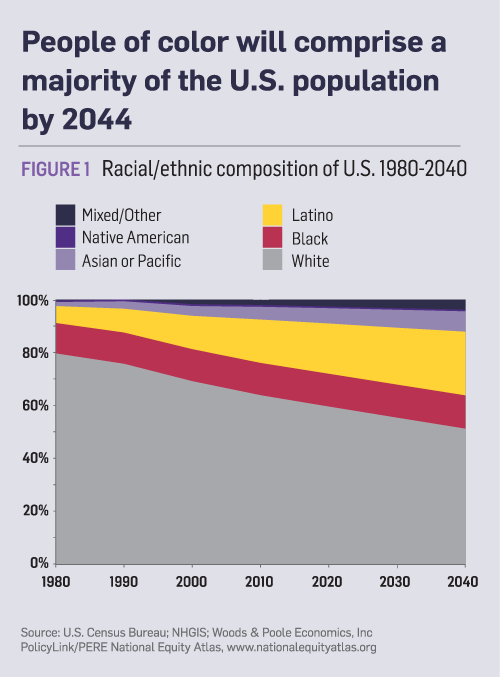 The United States is in the midst of a profound shift in our economy and demographics. Unemployment is down to its lowest level in nearly 10 years, yet inequality is rising rapidly and the percentage of working poor is growing, particularly in communities of color.2 Today’s anemic economy is a direct result of policies and practices that have denied full economic opportunity to people of color, squandering our most important economic resource—the talents and entrepreneurial energy of all our people. We will become a majority people of color nation by 2044; already, 46 percent of all youth are of color.3 Yet those entering the workforce today have fewer opportunities for economic mobility and success than their parents, even as these young people make up the most diverse generation in our nation’s history.
The United States is in the midst of a profound shift in our economy and demographics. Unemployment is down to its lowest level in nearly 10 years, yet inequality is rising rapidly and the percentage of working poor is growing, particularly in communities of color.2 Today’s anemic economy is a direct result of policies and practices that have denied full economic opportunity to people of color, squandering our most important economic resource—the talents and entrepreneurial energy of all our people. We will become a majority people of color nation by 2044; already, 46 percent of all youth are of color.3 Yet those entering the workforce today have fewer opportunities for economic mobility and success than their parents, even as these young people make up the most diverse generation in our nation’s history.
Investing in low-income communities and communities of color is essential for the future economic prosperity of our nation. If racial disparities in income and employment were eliminated, the U.S. economy would be $2.1 trillion larger than it is today.4 Economists have found that cities and regions with lower inequality experience more growth and less frequent and severe economic downturns.5 In other words, equity—just and fair inclusion in society so that all can participate, prosper, and reach their full potential—is not only a moral concern; it is an economic imperative.
Achieving equity will require widespread access to good jobs. Businesses from the new breed of “makers” to more established but innovative manufacturers can help to reduce inequality by creating new employment and shared prosperity. Recognizing the need for equitable growth, the Pratt Center for Community Development along with PolicyLink and the Urban Manufacturing Alliance launched the Equitable Innovation Economies Initiative (EIE) in 2014. 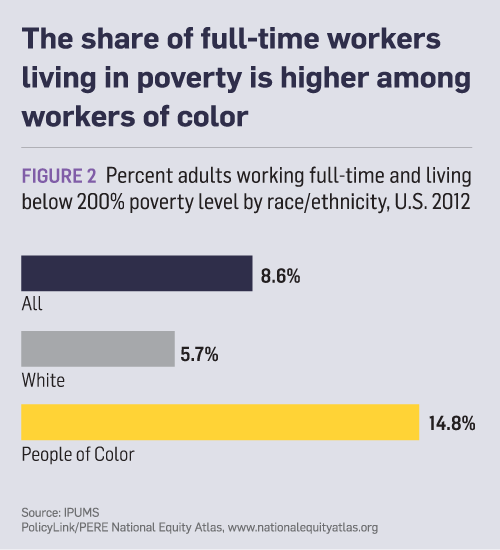 EIE is a learning cohort of cities that are taking deliberate action to embed equity and inclusion throughout their support for job creation and industrial growth. EIE helps cities pursue inclusive growth strategies in their innovation and manufacturing sectors to advance more equitable outcomes. In the current pilot phase, four cities—Indianapolis, New York City, Portland, OR, and San Jose, CA—have been collaborating to identify equity objectives, refine programmatic approaches, and track the impacts of their efforts focused on these sectors.
EIE is a learning cohort of cities that are taking deliberate action to embed equity and inclusion throughout their support for job creation and industrial growth. EIE helps cities pursue inclusive growth strategies in their innovation and manufacturing sectors to advance more equitable outcomes. In the current pilot phase, four cities—Indianapolis, New York City, Portland, OR, and San Jose, CA—have been collaborating to identify equity objectives, refine programmatic approaches, and track the impacts of their efforts focused on these sectors.
This is an account of the first two years of the EIE: why we launched it, how these cities collaborated to embed equity into their economic development programs related to manufacturing and innovation, and what we have accomplished and learned along the way. We hope it will spark conversation and inspire action to drive more inclusive growth in cities across the nation.
Equity in Innovation and Manufacturing
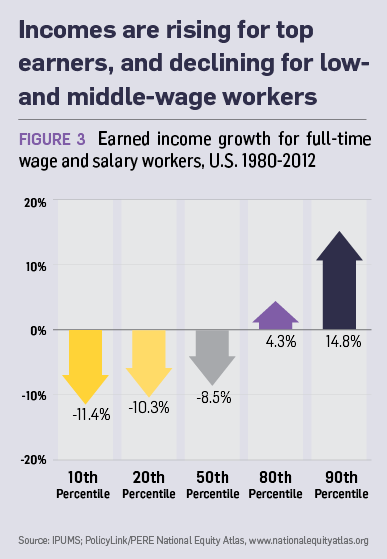 Cities across the U.S. are increasingly focusing their development efforts on innovation to spur economic growth. Known by many names—the creative economy, the knowledge economy, innovation districts, advanced industries, and more—this innovation economy comprises entrepreneurs, engineers, designers, makers, and manufacturers who are fueling jobs and growth across myriad industries by developing new products and more efficient and profitable ways to bring them to market.6
Cities across the U.S. are increasingly focusing their development efforts on innovation to spur economic growth. Known by many names—the creative economy, the knowledge economy, innovation districts, advanced industries, and more—this innovation economy comprises entrepreneurs, engineers, designers, makers, and manufacturers who are fueling jobs and growth across myriad industries by developing new products and more efficient and profitable ways to bring them to market.6
The innovation economy leverages assets such as universities, walkable urban neighborhoods, and dense social networks to launch new businesses, attract a skilled workforce, and create high-quality jobs. Cities are also spending billions in tax incentives and expenditures to foster new urban environments and attract companies to locate and grow in a particular place. For example, San Francisco recently created a temporary tax incentive program to bring tech companies to the downtown area. Last year, the program awarded $34 million in tax breaks to companies such as Twitter and Zendesk, which brought thousands of jobs into that part of the city.7
These investments in the innovation economy may create new jobs and drive economic growth, but for cities already confronting the loss of middle-wage jobs and widening economic and racial disparities, they have failed to reach low-income communities and communities of color. Cities with strong innovation clusters are finding that incomes are rising dramatically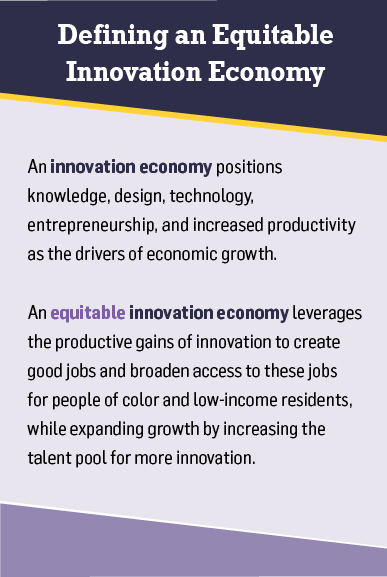 for top earners while stagnating or even declining for many low- and middle-wage workers.8 Studies have found that Black, Latino, Native American, and Southeast Asian communities are underrepresented in ownership and employment in tech and other innovation-driven companies.9 And while these businesses spur the creation of a large number of service and support jobs such as food service, security, and cleaning—which predominately employ people of color—wages in those jobs are less than a quarter of the average pay for a tech worker.10
for top earners while stagnating or even declining for many low- and middle-wage workers.8 Studies have found that Black, Latino, Native American, and Southeast Asian communities are underrepresented in ownership and employment in tech and other innovation-driven companies.9 And while these businesses spur the creation of a large number of service and support jobs such as food service, security, and cleaning—which predominately employ people of color—wages in those jobs are less than a quarter of the average pay for a tech worker.10
Meanwhile, rents and living costs are rising rapidly in innovation cities, adding to displacement pressures.11 Combined, these factors are contributing to a geographically and racially segregated economy, with higher-income workers in the innovation economy increasingly choosing to live in dense urban neighborhoods while working-class people of color are commuting long distances to work at low-paying service jobs in the city.
Innovation is transforming manufacturing in the 21st century
While these trends are most clearly seen in the tech sector, other innovation sectors such as manufacturing, long a bastion of middle class jobs, have also been affected. Despite job losses in recent decades, manufacturing is still a vital part of the American economy, employing 12 million workers and generating $2.1 trillion in GDP with broader spillover effects throughout the economy. It is also still an important industry of opportunity, providing jobs with decent pay and benefits to people with less than a college degree. For non-college educated workers, the average wage in manufacturing is ten percent higher than in non-manufacturing jobs.12
However, the industry is being reshaped by land use pressures, technological advances, global trade, and labor trends. These conditions present distinct challenges for cities that are working to grow good jobs through investments in their urban manufacturing sectors, and addressing them will require an intentional focus on equity and inclusion. In cities such as Boston and Minneapolis, public and private investments in urban industrial areas are raising the price of real estate and attracting primarily young professionals to live, work, and play in these areas, often squeezing out existing production and manufacturing businesses and jobs.13 At the same time, manufacturing itself has been transformed by innovation, echoing broader trends in the economy towards nimble, networked, and entrepreneurial structures and processes. Overall firm size has been declining over the last 15 years; the rise of technologies such as 3-D printing and a growing maker movement have opened up new pathways for small, niche, and artisanal manufacturers.14 However, many long-time city residents and people of color experience barriers to accessing the capital and business and social networks needed to participate in this new economy.
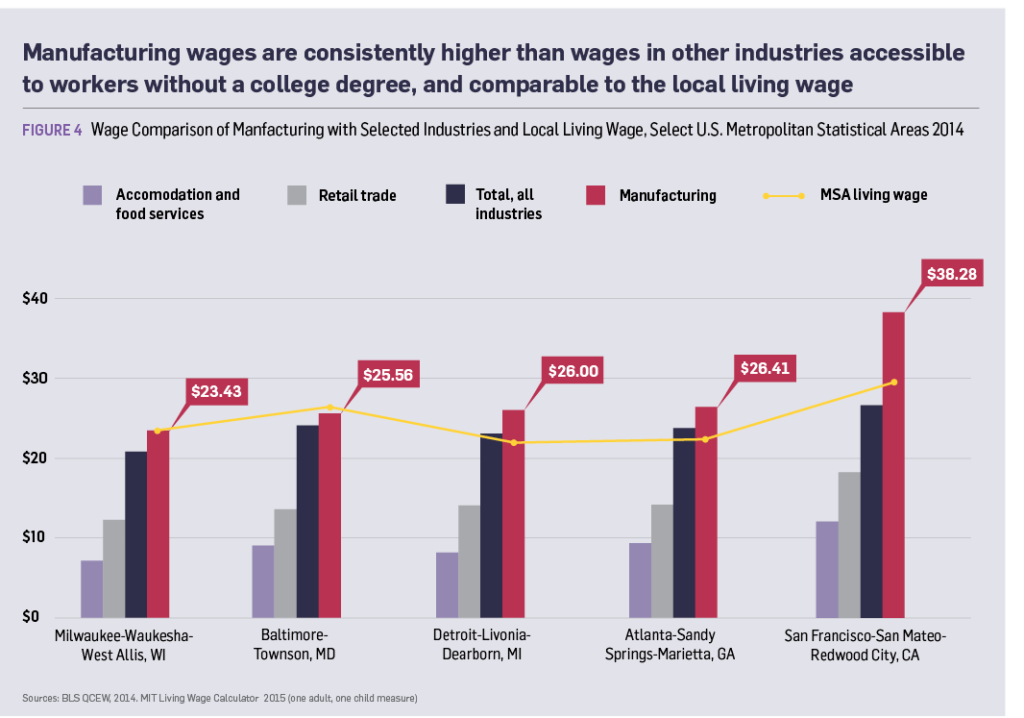

The industry is also at risk of losing its middle-wage jobs. Real wages in manufacturing declined by more than 4 percent between 2003 and 2013, and one out of four manufacturing workers today makes under $12 an hour.15 While there are still many high-paying jobs in areas like advanced manufacturing, these opportunities increasingly require technical degrees. This is contributing to a growing bifurcation within the manufacturing sector. Nationally, workers with less than a college degree and workers of color are concentrated in lower-wage occupations such as meat processing, which pays an average of $11.48 an hour.16
Pursuing an equitable innovation economy
Today, the innovation economy is contributing to rising inequality and a widening racial income and wealth gap. These outcomes are neither beneficial for innovation, nor inevitable. A growing body of research is showing that racial inclusion can increase levels of innovation and growth by tapping into the talent pool that exists in many of our cities’ communities of color. Studies show that diverse companies are more innovative and reduced income inequality may actually lead to more inventors, who create more new technologies and drive innovation forward.17
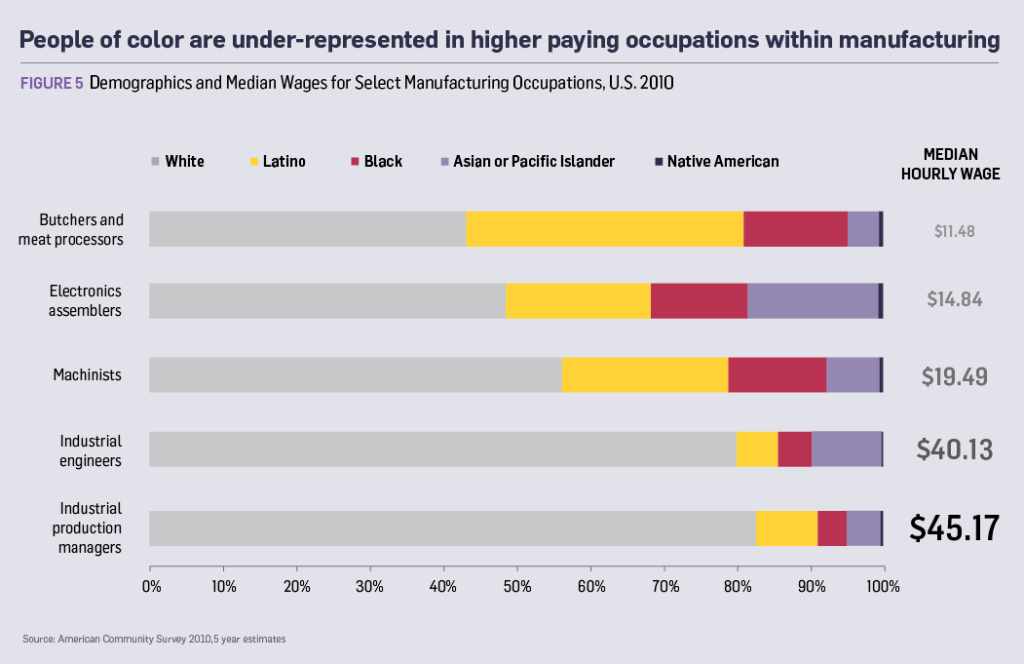

How can cities pursue an equitable innovation economy? It begins with the following principles for achieving equity-driven growth:
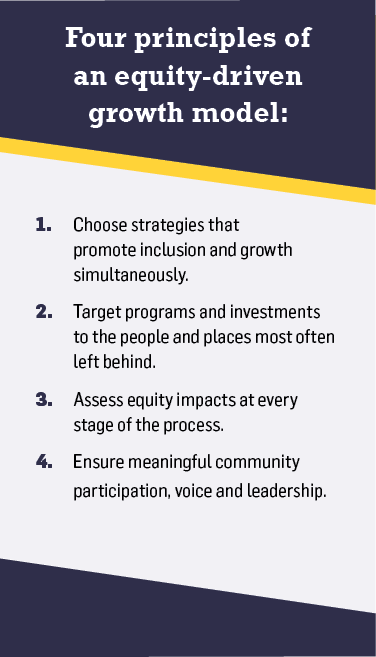
- Choose strategies that promote equity and growth simultaneously. Traditional economic development approaches equity and growth as a zero-sum game, in which one is realized at the expense of the other. But both are needed in order to achieve prosperity. Successful initiatives will identify win-win strategies that maximize both job creation and job opportunities for local residents.
- Target programs and investments to the people and places most left behind. Focusing economic development resources on low-income families and communities that have been left behind will produce the greatest returns on these investments.
- Assess equity impacts at every stage of the policy process. As new policies and programs are developed and implemented, it is important to ask three fundamental questions: Who will pay? Who will benefit? Who will decide? Knowing the answers will help to determine if there are communities being left out or paying an undue burden.
- Ensure meaningful community participation, voice, and leadership. As we become a majority people-of-color nation, all Americans must have access to the decision-making processes impacting their lives and an ability to shape these decisions.
Growth in the innovation economy, with its focus on technology, entrepreneurship, and productivity, can present an opportunity to bolster local economies and create quality jobs. But how cities pursue innovation matters. Equity and inclusion are not baked in to the current model for innovation economies; it will require an intentional focus on overcoming structural racism and institutional barriers that have excluded many low-income communities and people of color from the wealth and benefits of this emerging economic driver.
In cities across the country, a wide range of communities and stakeholders are coming together to advance strategies to create inclusive innovation economies:
- In Pittsburgh, Pennsylvania, the Urban Innovation21 public-private partnership has leveraged the Keystone Innovation Zone program, a placed-based statewide tax credit program incentivizing innovation, to drive the region’s “inclusive innovation” agenda. It uses a
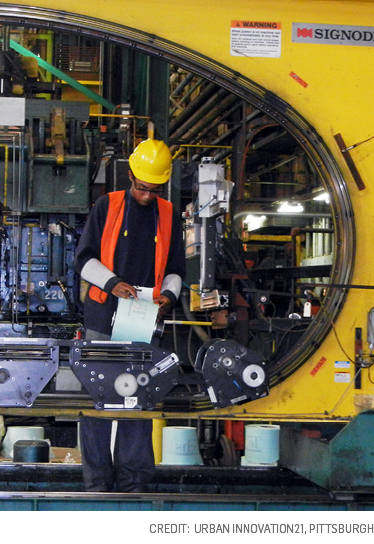 combination of tax incentives, entrepreneurship support, educational and internship programs, and networking events to support the growth of over 60 startups with a higher-than-average proportion of African American-owned businesses. In ten years, these startups have created over 500 jobs and provided 600 paid internship opportunities for women, African Americans and firstgeneration college students. Their strategy connects the region’s innovation-fueledgrowth to create economic development that benefits residents in the historically Black neighborhoods of the Hill District and Homewood, such as opening a grocery store in what was once a food desert and creating tech accelerators and co-working spaces that support community business efforts.
combination of tax incentives, entrepreneurship support, educational and internship programs, and networking events to support the growth of over 60 startups with a higher-than-average proportion of African American-owned businesses. In ten years, these startups have created over 500 jobs and provided 600 paid internship opportunities for women, African Americans and firstgeneration college students. Their strategy connects the region’s innovation-fueledgrowth to create economic development that benefits residents in the historically Black neighborhoods of the Hill District and Homewood, such as opening a grocery store in what was once a food desert and creating tech accelerators and co-working spaces that support community business efforts.
- In Oakland, California, a coalition of 30 community organizations, labor groups, and the city adopted a community benefits agreement for the Oakland Army Base, a $800 million, 250-acre transportation and logistics center that will improve operational efficiencies of the adjacent port. The agreement provides specific goals on living wages, as well as provisions for local hiring once the project is built out. A community jobs oversight commission meets monthly to track progress on these goals. Nearly three years into the agreement, the project has met or exceeded all of its targets for hiring local residents and people with barriers to employment.18
- In New York City, the Brooklyn Navy Yard has been transformed into a hotbed for urban manufacturing, offering affordable industrial space for local makers and manufacturers. They’ve recently launched New Lab, an 84,000 square foot advanced manufacturing hub that will house engineers, designers, and entrepreneurs developing products in robotics, connected devices, and other emerging fields. The Brooklyn Navy Yard creates pathways to jobs through partnerships with nearby public housing projects, local community organizations, and
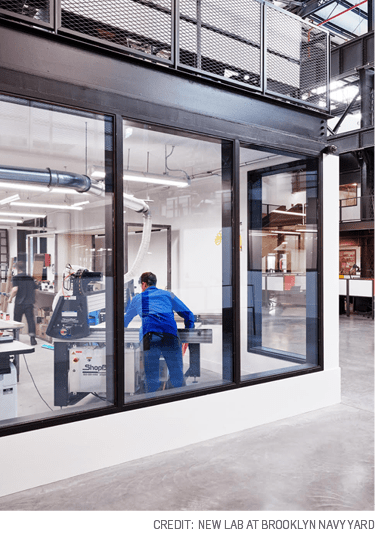 workforce agencies. The Navy Yard today is home to over 300 businesses employing more than 7,000 people.Theirprogramming includes an on-site recruitment and placement center and a growing internship program. They are targetingtenants who commit to hire through the workforce center and adhere to certain job quality standards.
workforce agencies. The Navy Yard today is home to over 300 businesses employing more than 7,000 people.Theirprogramming includes an on-site recruitment and placement center and a growing internship program. They are targetingtenants who commit to hire through the workforce center and adhere to certain job quality standards.
More and more, cities and communities are deploying strategies like these to leverage their manufacturing, high-tech, and other creati
ve industries to grow their economies and create
opportunities in low-income communities of color. The following sections will describe how we have pursued equitable growth strategies within the Equitable Innovation Economies Initiative (EIE) and describes the work of our four pilot cities: Portland, Indianapolis, San Jose, and New York City.
Collaborating on Local Strategies to Advance Equity
The vision for the Equitable Innovation Economies Initiative (EIE) stems from the recognition that achieving more inclusive growth will require new and uncharted approaches. Testing these approaches through a collaborative process creates an opportunity for cities to openly experiment with new ideas, learn from peers, and discuss challenges in a supportive space. While the central goal of the initiative is to help cities pursue equitable growth in their manufacturing and innovation economies, it is also intended to model a “community of practice” for achieving these goals.
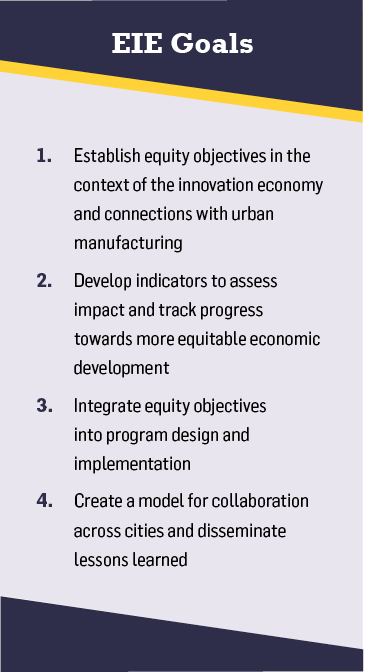 The Urban Manufacturing Alliance’s (UMA) expansive network and ground-up organizational model serves as an ideal platform for the EIE community of practice. With over 125 member cities, the UMA regularly convenes a diverse set of economic development practitioners, including government, academic, and non-profit leaders, to discuss priority challenges and brainstorm solutions. At the UMA’s 2013 National Convening, themes around equity and the shifting nature of manufacturing were at the forefront of discussions. Several cities were wrestling with the questions that formed the basis for EIE, including: What are the potential economic impacts of the maker movement, and could it catalyze growth in the urban manufacturing sector? How will advanced manufacturing technologies impact traditional manufacturers and their workforce? And how could cities pursue better innovation-focused investments that prioritize equitable job creation and inclusion?
The Urban Manufacturing Alliance’s (UMA) expansive network and ground-up organizational model serves as an ideal platform for the EIE community of practice. With over 125 member cities, the UMA regularly convenes a diverse set of economic development practitioners, including government, academic, and non-profit leaders, to discuss priority challenges and brainstorm solutions. At the UMA’s 2013 National Convening, themes around equity and the shifting nature of manufacturing were at the forefront of discussions. Several cities were wrestling with the questions that formed the basis for EIE, including: What are the potential economic impacts of the maker movement, and could it catalyze growth in the urban manufacturing sector? How will advanced manufacturing technologies impact traditional manufacturers and their workforce? And how could cities pursue better innovation-focused investments that prioritize equitable job creation and inclusion?
Through a competitive application process in 2014, Pratt Center and PolicyLink selected four cities – Indianapolis, New York City, Portland, OR, and San Jose, CA – to participate in the EIE pilot working group. As a baseline, each city was asked to identify a focus program area or initiative targeted at creating opportunities within the innovation economy or manufacturing sector. Each city’s team proposed ideas for how to explore and improve the equity impacts of their work and committed staff time to this process. Finally, each project was led or supported by a municipal agency with a mandate for implementation. The Surdna Foundation provided both financial support and played an important role as a thought partner, helping us to place this work in a national context.
Structure of the EIE Pilot
In the fall of 2014, twenty participants from the four pilot cities, Pratt Center, and Policylink formally launched the EIE at UMA’s national convening in Philadelphia. Over the course of a day, the group shared aspirations, described local contexts and equity challenges, and committed to a set of common goals. At the outset, the cities identified several important factors that would shape their projects: establishing equity objectives for each focus project; refining program strategies and engaging diverse stakeholders, and establishing equity indicators to track impacts.
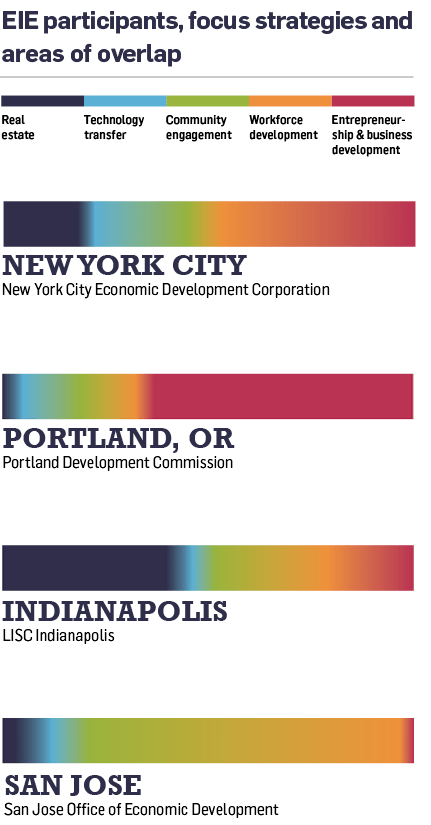 Facilitated by Pratt Center and PolicyLink, the EIE pilot provided a set of tools and resources for each city to individually work towards the goals they identified as well as a platform for cross-learning and information exchange at critical points along the way. Through conference calls and group convenings, the pilot group continuously updated each other on progress and addressed stumbling blocks. Each city expanded its local network, reaching out to local partners and bringing additional resources to thetable. While the path was iterative, it was guided by a set of tools that served as a process map for the group and can equip other cities working towards similar milestones.
Facilitated by Pratt Center and PolicyLink, the EIE pilot provided a set of tools and resources for each city to individually work towards the goals they identified as well as a platform for cross-learning and information exchange at critical points along the way. Through conference calls and group convenings, the pilot group continuously updated each other on progress and addressed stumbling blocks. Each city expanded its local network, reaching out to local partners and bringing additional resources to thetable. While the path was iterative, it was guided by a set of tools that served as a process map for the group and can equip other cities working towards similar milestones.
FOCUS STRATEGIES
Each EIE pilot city focused on a deliberate, holistic approach that integrated equitable growth principles into land use, business development, entrepreneurship, technology transfer, and workforce strategies while preserving or creating good job opportunities for people with a range of skills and backgrounds. Here are select strategies the pilot cities focused on:
FROM TOP: (1) Pensole Academy, Portland, aims to create the next generation of footwear designers by teaching students the entire footwear design process from concept to branding, (2) A robotic arm in operation at San Jose-based metal fabricator Vander-Bend Manufacturing, (3) Indianapolis-based RecycleForce provides a wide array of recycling services in Indiana and employment opportunities for formerly incarcerated individuals, and (4) Keith Kirkland, co-founder of Wear.Works, showcases a slick new working prototype that the team finalized for New York’s Next Top Makers showcase event in May 2016.
- Support entrepreneurs of color in manufacturing and innovation. Many entrepreneurs of color face unique challenges tostarting and growing their own companies, including barriers to accessing affordable capital, lack of access to mainstream business assistance and networks, and other challenges. Programs that are supporting innovation entrepreneurs should take deliberate action to ensure they are effectively reaching, recruiting, and retaining people of color.19 In New York City, the Next Top Makers program intentionally recruited workshop speakers from diverse backgrounds to help reach into more communities. In Portland, the Portland Development Commission runs an accelerator that focuses on people from communities that are underrepresented in tech and innovation and has helped to launch a startup fund to invest in companies with diverse founders.
- Preserve and invest in industrial land and stable, affordable housing simultaneously.Cities with robust innovation sectors are challenged to both preserve middle-wage jobs in industrial areas and improve housing for low-income workers. Land use
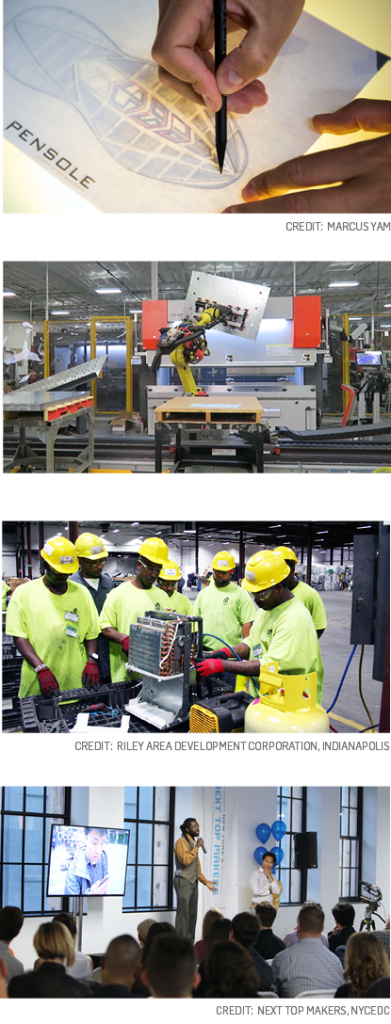 strategies should pursue both affordable housing and preservation of middle-wage jobs simultaneously. San Jose chose to prioritize industrial and manufacturing uses in its industrial land rather than convert it to office parks or housing while also promoting affordable housing development along transit corridors. In Indianapolis, the city and partners are re-investing in urban industrial corridors to revitalize manufacturing activity, increase employment opportunities, and stabilize nearby neighborhoods. This includes participation of community groups in the revitalization process to ensure ongoing advancement of equity goals.
strategies should pursue both affordable housing and preservation of middle-wage jobs simultaneously. San Jose chose to prioritize industrial and manufacturing uses in its industrial land rather than convert it to office parks or housing while also promoting affordable housing development along transit corridors. In Indianapolis, the city and partners are re-investing in urban industrial corridors to revitalize manufacturing activity, increase employment opportunities, and stabilize nearby neighborhoods. This includes participation of community groups in the revitalization process to ensure ongoing advancement of equity goals. - Invest in job training into skilled manufacturing jobs for residents with barriers to employment. Job training and placement programs can help manufacturers find workers with the right skills while creating pathways into jobs that pay family-supporting wages. In San Jose, the city helped to connect young people from disadvantaged communities to employment opportunities with local manufacturers looking for talent.
- Prioritize the creation of jobs that pay a living wage. Jobs that pay good wages and provide career opportunities in the innovation economy and manufacturing help to drive economic growth that benefits all workers. In Indianapolis, LISC is working with a local developer to track workforce demographics, wages, and opportunities for advancement in the companies that locate in a new industrial site. Their goal is to ensure that businesses are providing good jobs and opportunities for local residents.
- Strengthen the manufacturing base through technology transfer partnerships. Access to advanced manufacturing technologies and product development opportunities can help existing manufacturers compete. Strategies that facilitate technology transfer partnerships between R&D firms, universities, business extension partners, and other service providers enable manufacturers to adopt the latest technologies and provide skills training for their workforce. New York City has launched FutureWorks, a new program that will support early stage companies using or developing new technologies and products and help existing manufacturers integrate advanced manufacturing processes.
- Deepen partnerships and expand networks into low-income communities of color.Building long-term and authentic relationships with local community members can help to ensure that the priorities and strategies a city implements will be responsive to the needs of the communities they are intended to benefit. In Portland, the Portland Development Commission has adopted a new strategic plan that acknowledges the agency’s history of contributing to the displacement of Portland’s African American community and commits to becoming an anti-racist, multicultural organization and building long-term relationships in communities of color.

The EIE Approach to Advancing Equity Strategies
The EIE pilot modeled a unique approach for evaluating existing strategies through an equity lens while also broadening conversations on these issues amongst leaders in peer cities. This process differs from the status quo in economic development practice. EIE’s focus is specifically on the innovation economy and manufacturing, leveraging assets such as entrepreneurship programs, advanced manufacturing firms, and makerspaces to create more diverse and good quality jobs. The participating cities committed to an in-depth assessment of equity impacts and to openly sharing progress and challenges throughout the process. While strategies differed across cities, the pilot group was able to provide valuable input and guidance on each other’s work, reflected in meaningful shifts in approaches.
THE EIE PILOT PROCESS
The framework for the EIE pilot spanned three broad phases: defining the problem and potential impacts, discussing and refining strategies with a range of partners such as community groups, universities, and businesses, and establishing equity indicators. Each of these phases informed the other: for instance, analysis of baseline data led to refinement of program strategies, and conversations with stakeholders revealed insights about perceived barriers or brought new resources into play. The EIE process is just one approach to advancing local equity strategies and is a work-in-progress. Our hope is that by sharing this methodology, we will elicit ideas from others pursuing similar work and add to resources for the field.
I. Visioning Success: Defining Equity Objectives and Potential Impact
In the first part of this process, the pilot cities reflected on the baseline context in their cities and visualized what success might look like for each project. The objective of this work was to identify and engage the target beneficiaries of each strategy, define the barriers they confront, and solidify equity objectives.
Process:
- Discuss critical equity objectives both at a city level and for the program strategy of focus. In several of the pilot cities, two categories of objectives emerged: goals related to the population level, such as wealth creation in a specific neighborhood or job placements at the citywide scale, as well as program level objectives such as businesses launched in an incubator. In some instances, cities used this step to translate policy directives into more specific, tangible program goals.
- Identify which groups will be most impacted by pursuing these objectives.What is the target population and what barriers to access do they face? We looked at five different groups and places that may be impacted by this work: businesses, workers, residents, neighborhoods, and the city overall. Within each of these, we disaggregated their populations to think about the consequences for different subgroups (for example, minority-owned, women-owned, small, or local businesses).
- Prioritize equity objectives. We tried to more precisely define the problem being solved and narrow down objectives as much as possible by gathering new information. For example, some cities analyzed barriers and potential opportunities for beneficiary groups by collecting initial baseline data, and then evaluated their capacity to act on this information.
II. Expanding Approaches: Engaging Stakeholders and Refining Program Strategies
The objective of this phase was to understand how current programs and partnerships support objectives and assess opportunities to refine or add to current strategies. Engaging current and new stakeholders was central to this process (a stakeholder is defined as anyone who will be, or should be, impacted by a program). Each city focused on mapping the partners they were currently working with on their equity goals. They then identified challenges in program implementation and additional stakeholders to engage in brainstorming solutions.
Process:
- Integrate new perspectives in strategy design. The EIE cities brought beneficiary groups and other stakeholders into program development discussions to gain firsthand perspectives on what has and has not worked. Throughout the pilot process, cities engaged a range of partners, from other city agencies to non-profit organizations to funders.
- Find analogous examples in the field. Learning from other cities was an invaluable way to quickly identify examples of both successes and failures in program design. The EIE group and its peer cities provided a natural platform for information exchange. We also created an online resource library cataloguing best practices and relevant examples from across the country and made connections to other UMA cities and experts in the field.
- Create an implementation plan. How can strategies be realigned and operationalized to achieve more equitable outcomes? An important aspect of this process was assigning roles among project partners, and discussing the right private and philanthropic sources of funding for implementation.
III. Establishing Equity Indicators to Measure Impact
From the outset, the EIE process emphasized data collection as a means to illustrate impacts and outcomes of these pilot efforts, informing ways to refine or possibly scale this work. We approached this by creating a long list of indicators customized to each program strategy based on potential program level and population level outcomes. The cities then identified what was feasible: for instance, they looked at what data was readily available, the process and tools they would need to collect new data, and how meaningful this information might be over time. Most were able to commit to developing 3-5 indicators in the short term, collected through short surveys tied to program activities or investments. For example, Indianapolis will be collecting employment and wage data in an industrial redevelopment project, and New York City will be assessing how outreach to communities of color impacts their involvement in the Next Top Makers program.
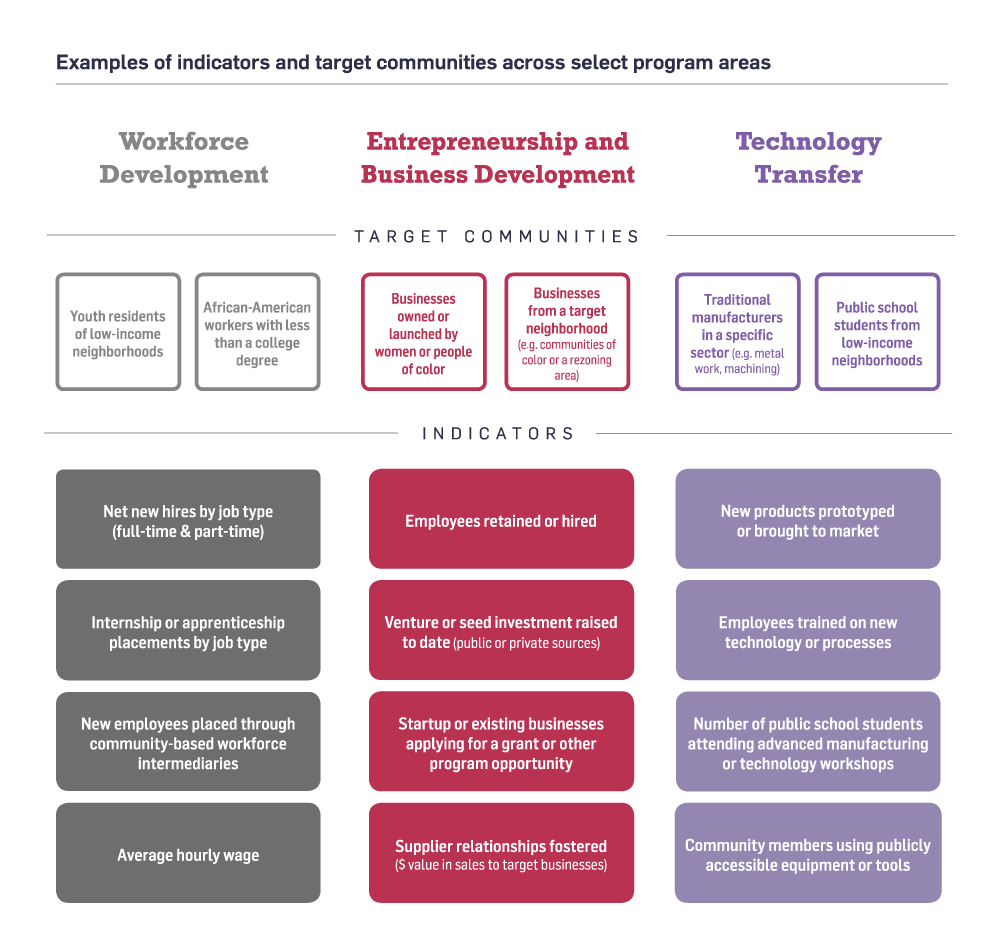
Conclusion
The success of this pilot year in advancing local equity strategies is a testament to the bold, creative, and visionary thinking of the city participants. These leaders invested time and energy to an issue that did not always have an organizational mandate, or needed translation from a policy directive into action steps. Each city was able to define an equity focus, identify their data gaps, and move forward with implementation while negotiating local constraints and partnerships.
The EIE pilot also yielded insights into the broader need and challenges for the field. While the community of practice built comfort around discussing issues of equity and race, it is a very long-term process to change direction to achieve more equitable outcomes. Building relationships with community partners and other stakeholders can take time, but it is necessary to begin early in the process in order to include their voice when deciding on strategies and how to measure impact in meaningful ways. The lack of reliable data on the economic impact and demographics of the innovation economy and urban manufacturing was highlighted as an ongoing challenge for decision-making.
Although each participant was able to push their work forward, each city experienced political transitions and organizational changes that required broader engagement to ensure replicability and scale of equity-focused strategies. Finally, while facilitating dialogue was often challenging amongst the pilot cities given the range of strategies and local contexts, it was also an invaluable means for building a community of like-minded leaders that can continue to advance this work locally.
Endnotes
1. Barack Obama, “Remarks by the President at White House Demo Day.” Speech, Washington D.C., August 4, 2015.
2. National Equity Atlas and Alan Krueger, Laurence Katz, “The Rise and Nature of Alternative Work Arrangements in the U.S., 1995-2015.” March 29, 2016.
3. National Equity Atlas
4. Sarah Treuhaft, Justin Scoggins, and Jennifer Tran. “The Equity Solution: Racial Inclusion Is Key to Growing a Strong Economy.” PolicyLink and USC Program for Environmental and Regional Equity. 2014.
5. Chris Benner and Manuel Pastor, “Brother, Can You Spare Some Time? Sustaining Prosperity and Social Inclusion in America’s Metropolitan Regions,” Urban Studies: 2014.
6. See, for example, John Howkins, The Creative Economy: How People Make Money From Ideas, Penguin Books, 2001. Mark Muro, Jonathan Rothwell, Scott Andes, Kenan Fikri, and Siddarth Kulkarni, “America’s Advanced Industries: What They Are, Where They Area, and Why They Matter,” Brookings, 2015. Bruce Katz and Julie Wagner, “The Rise of Innovation Districts: A New Geography of Innovation in America,” Brookings, 2014.
7. Marissa Lang, “Companies Avoid $34M in City Taxes Thanks to ‘Twitter Tax Break’,” San Francisco Chronicle, October 19, 2015.
8. Richard Florida, “The Connection Between Successful Cities and Inequality,” CityLab, January 6, 2015.
9. Silicon Valley Rising, “Tech’s Diversity Problem: More Than Meets the Eye,” undated.
10. Ian Hathaway, “Technology Works: High-Tech Employment and Wages in the United States,” Bay Area Council Economic Institute, 2012. Working Partnerships USA, “Tech’s Invisible Workforce,” 2016.
11. Richard Florida, “Tech Culture and Rising Inequality: A Complex Relationship.” CityLab, December 9, 2014.
12. Robert E. Scott, “The Manufacturing Footprint and the Importance of U.S. Manufacturing Jobs.” EPI Briefing Paper. January, 2015.
13. See, for example: Tim Logan, “Soaring rents squeezing Boston-based industrial firms,” Boston Globe, September 23, 2015. Eric Roper, “Changing Minneapolis puts squeeze on industrial land,” Star Tribune, August 29, 2105.
14. Nisha Mistry and Joan Byron, “The Federal Role in Supporting Urban Manufactruing,” Pratt Center for Community Development and Brookings, April 6, 2011.
15. Catherine Ruckelshaus and Sarah Leberstein, “Manufacturing Low Pay: Declining Wages in the Jobs That Built America’s Middle Class,” National Employment Law Project, 2014.
16. Author analysis of census data.
17. Sylvia Ann Hewlett, Melinda Marshall, and Laura Sherbin, “How Diversity Can Drive Innovation,” Harvard Business Review, December 2013. Dylan Matthews, “The great invention gap between rich and poor kids – and why it matters,” Vox, March 16, 2015.
18. Fran Smith, “Oakland Army Base Is a Model for Equitable Development,” Next City, February 19, 2016.
19. For more on the challenges and effective strategies, see the Initiative for a Competitive Inner City “Creating Inclusive High-Tech Incubators and Accelerators,” 2016.
